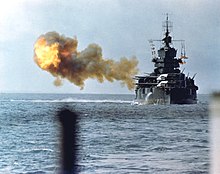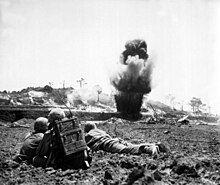Battle of Okinawa
| Battle of Okinawa | |||||||
|---|---|---|---|---|---|---|---|
| Part of World War II, the Pacific War | |||||||
 A Marine from the 2nd Battalion, 1st Marines on Wana Ridge provides covering fire with his Thompson submachine gun, May, 1945 | |||||||
| |||||||
| Belligerents | |||||||
|
|
| ||||||
| Commanders and leaders | |||||||
|
|
| ||||||
| Strength | |||||||
| 183,000[1] | 117,000[2] | ||||||
| Casualties and losses | |||||||
|
12,513 killed 38,916 wounded, 33,096 non-combat losses |
About 95,000 killed 7,400–10,755 captured | ||||||
| Estimated 42,000–150,000 civilians killed | |||||||
The Battle of Okinawa was a great battle of World War II. It took place on Okinawa Island in the Ryukyu Islands (south of the four big islands of Japan). The battle was between the military forces of the Empire of Japan and the Allies. It was the second biggest amphibious battle (from sea to land) of World War II, after the Battle of Normandy. It was also one of the longest battles in history, from April to June 1945. The Allies won the battle and occupied Okinawa. Today, Okinawa is Japanese territory, but there are still American military bases there.
The Battle of Okinawa is considered to be the last major battle of World War II. The Americans were planning Operation Downfall, the invasion of the four great islands of Japan. This never happened, since the Japanese surrendered after the American use of the atomic bomb in August 1945 (first in Hiroshima, and a second time in Nagasaki) and the Soviet Union declaring war on Japan.
The battle has been called "Typhoon of Steel" in English, and "tetsu no ame," "tetsu no bōfū" by the people of Okinawa, which mean "rain of steel" and "violent wind of steel", because of the very heavy firing of guns and bombs at this battle.
Some battles, such as the Battle of Iwo Jima, had no civilians present, but Okinawa had a large civilian population. The civilians killed or injured in the battle were at least 150,000. American deaths were 18,900 killed or missing and 53,000 injured, more than double of the soldiers killed at Iwo Jima and Guadalcanal put together. Several thousand soldiers who died from wounds and other causes after the battle had finished, are not included. About a third of the civilian population of the island were killed.
There were about 100,000 Japanese soldiers killed and 7,000 captured. Some of the soldiers committed seppuku or simply blew themselves up with grenades. Some of the civilians, convinced by Japanese propaganda that the Americans were barbarians who did terrible things to prisoners, killed their families and themselves to avoid capture.
In 1945, Winston Churchill called the battle "among the most intense and famous in military history."'
Order of battle[change | change source]
Allied[change | change source]


Overall Allied command authority for battle was Fifth Fleet (under Admiral Raymond A. Spruance).[3] Fifth Fleet was divided into several task forces and groups.
TF 56 was the largest force within TF 50 and was built around the 10th Army. The army had two corps under its command. In all, the Army had over 102,000 Army (of these 38,000+ were artillery, combat support and HQ troops, with another 9,000 service troops),[3] over 88,000 Marines and 18,000 Navy personnel (mostly Seabees and medical personnel).[4]
At the start of the Battle of Okinawa the 10th Army had 182,821 men under its command.[4] The U.S. Navy had greater casualties in this operation than in any other battle of the war.[5]
Japanese[change | change source]

The Japanese land campaign (mainly defensive) was had 67,000 men (77,000 according to some sources). As well, there were 9,000 Imperial Japanese Navy (IJN) troops at Oroku naval base. There were also 39,000 local Ryukyuan people who were forced to fight.
[change | change source]

The United States Navy's Task Force 58 was east of Okinawa. It had 6 to 8 destroyers and 13 carriers. Admiral Chester W. Nimitz gave his naval commanders time to rest.
Japanese air attacks had been light during the first few days after the landings. However, on 6 April, there was an attack by 400 planes from Kyushu. From 26 March-30 April, 20 American ships were sunk and 157 damaged.
The Japanese had lost up to more than 1,100 planes in the battle.[6]
Between 6 April and 22 June, the Japanese flew 1,465 kamikaze aircraft attacks. Several fleet carriers were severely damaged.
Operation Ten-Go[change | change source]

Operation Ten-Go (Ten-gō sakusen) was the attack by ten Japanese ships. In all, the Imperial Japanese Navy lost 3,700 sailors, including Admiral Itō. The US lost just 10 U.S. aircraft and 12 airmen.
British Pacific Fleet[change | change source]
The British Pacific Fleet was ordered to attack Japanese airfields in the Sakishima Islands.
Land battle[change | change source]

The land battle took place over about 81 days beginning on 1 April 1945. The first Americans ashore were soldiers of the 77th Infantry Division, who landed west of Okinawa on 26 March.
On 31 March, Marines of the Fleet Marine Force Amphibious Reconnaissance Battalion landed without opposition on Keise Shima.
Northern Okinawa[change | change source]

The main landing was made by XXIV Corps and III Amphibious Corps on the western coast of Okinawa on 1 April.
The 10th Army moved across[7] the south-central part of the island. They captured the Kadena and the Yomitan airbases.
Six days later on 13 April, the 2nd Battalion, 22nd Marine Regiment reached Hedo Point (Hedo-misaki) at the northern part of the island. Japanese forces in the north were on the Motobu Peninsula.
The 77th Infantry Division attacked Ie Island (Ie Shima) on 16 April.
Southern Okinawa[change | change source]
The U.S. Army 96th Infantry division and 7th Infantry Division went south across Okinawa. The 96th Infantry Division had violent fights with Japanese troops in fortified positions. They had 1,500 battle casualties, while killing or capturing about 4,500 Japanese.
The next American goal was Kakazu Ridge. The Japanese soldiers hid in caves. There were many casualties on both sides.
On the evening of 12 April, the 32nd Army attacked U.S. positions. The attackers retreated. A final attack on 14 April was again stopped.
The launched a new attack on 19 April with 324 guns, the largest ever in the Pacific Ocean war. Then 650 Navy and Marine planes attacked with napalm, rockets, bombs, and machine guns.

A tank attack failed with the loss of 22 tanks. XXIV Corps lost 720 men KIA, WIA and MIA.

On 4 May, the 32nd Army launched another attack. This time, Ushijima tried to land troops on the coasts behind American lines. Japanese artillery fired 13,000 rounds. The attack failed.
Buckner launched another American attack on 11 May. By the end of May, monsoon rains turned hills and roads into mud.

On 29 May, Maj. Gen. Pedro del Valle ordered Company A, 1st Battalion, 5th Marines to capture Shuri Castle.
The Japanese retreat moved nearly 30,000 men into its last defense line on the Kiyan Peninsula. The 4,000 Japanese sailors — including Admiral Minoru Ota — all committed suicide.
On 18 June, Gen. Buckner was killed by enemy artillery fire. The last Japanese stopped fighting on 21 June, although some Japanese stayed hidden.[8]
References[change | change source]
- ↑ Appleman, Roy E.; James M. Burns; Russell A. Gugeler; John Stevens (2000). Okinawa: the last battle. Washingto, D.C.: United States Army Center of Military History. p. 36. Archived from the original on 2009-09-26. Retrieved 2011-01-30.
{{cite book}}: CS1 maint: multiple names: authors list (link) - ↑ Brooks, Risa (2007). Creating Military Power: The Sources of Military Effectiveness. Stanford University Press. p. 41. ISBN 978-0-8047-6809-2.
- ↑ 3.0 3.1 Rottman, Gordon (2002). Okinawa 1945: The last Battle. Osprey Publishing. p. 38. ISBN 978-1-84176-546-4.
- ↑ 4.0 4.1 Rottman, Gordon (2002). Okinawa 1945: The last Battle. Osprey Publishing. p. 40. ISBN 978-1-84176-546-4.
- ↑ "World War II Casualties". Naval History and Heritage Command. 30 April 2015. Retrieved 20 February 2016.
- ↑ "OKINAWA: THE LAST BATTLE, Chapter 4, Page 102". Archived from the original on 2 January 2009. Retrieved 11 June 2012.
- ↑ "Action in the North, Chp 6 of Okinawa: Victory in the Pacific by Major Chas. S. Nichols, Jr., USMC and Henry I. Shaw, Jr". Historical Section, Division of Public Information, U.S. Marine Corps. Archived from the original on April 13, 2010. Retrieved May 7, 2010.
- ↑ ""The World is beginning to know Okinawa": Ota Masahide reflects on his life from the Battle of Okinawa to the Struggle for Okinawa". Japanfocus.org. Retrieved 2012-05-06.
Other websites[change | change source]
- WW2DB: Okinawa Campaign
- US military on the Battle of Okinawa
- New Zealand account with reference to Operation Iceberg
- USS Gilbert Islands CVE 107. 1945 {at Okinawa}
- United States Army in World War II The War in the Pacific Okinawa: The Last Battle
- Global Security history of Battle of Okinawa particular combat fatigue figures Archived 2007-10-02 at the Wayback Machine
- History Online about Battle of Okinawa particular force strengths and casualties on both sides
